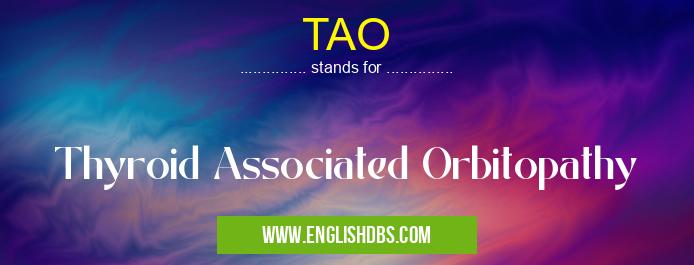What does TAO mean in PHYSIOLOGY
Thyroid Associated Orbitopathy (TAO) is a disorder that is characterized by an autoimmune reaction in the tissues of the orbit, the area which surrounds the eyeball. This affliction is also known as Graves' Orbitopathy or Ophthalmopathy. It usually presents with inflammation and enlargement of muscles and tissues behind and around the eyes, leading to various signs and symptoms such as redness, bulging of eyes, double vision, eyelid retraction and dryness. While TAO can occur at any age, it is most commonly seen in individuals with an underlying thyroid condition such as Grave's disease. Besides affecting physical appearance, TAO may also lead to complications including decreased vision due to proptosis or optic nerve compression.

TAO meaning in Physiology in Medical
TAO mostly used in an acronym Physiology in Category Medical that means Thyroid Associated Orbitopathy
Shorthand: TAO,
Full Form: Thyroid Associated Orbitopathy
For more information of "Thyroid Associated Orbitopathy", see the section below.
» Medical » Physiology
Causes
The exact cause for TAO remains unknown; however it has been linked to autoimmune disorders such as Graves’ Disease. In these cases, there appears to be an immune system attack on the tissue behind and around the areas surrounding the eyes which leads to inflammation and changes in other eye components such as orbital fat pads or extraocular muscles (the muscles that move your eyes). The antibodies that are responsible for this attack are thyroid stimulating immunoglobulins which have an affinity for orbital tissues more than they do for thyroid tissue. In some cases, however, TAO can occur without evidence of an underlying thyroid disorder initially; this is known as ‘Isoimmune’ TAO.
Signs & Symptoms
The signs and symptoms associated with TAO vary depending on its severity but generally include inflammation of conjunctiva (the thin membrane covering the white part of your eye), swelling of eyelids, double vision or diplopia (due to misalignment of eyes or eyeball displacement), redness or blurring of vision along with other visual disturbances like photophobia or floaters in vision etc. In some cases there might be problems with tear secretion too leading to dryness in eyes. Protrusion or bulging outwards of one or both eyeballs may also occur because of enlarged extraocular muscles causing it especially when looking sideways.
Diagnosis & Treatment
Diagnosis will begin by taking a detailed medical history along with physical examination followed by investigations like imaging studies like CT scan or MRI scans helping to rule out any underlying tumor-like conditions if present at all. Blood tests including TSH levels should also be done to detect any existing thyroid condition accompanying TAO if present at all apart from testing for levels of anti-TSH autoantibodies present too aiding in diagnosis further making sure it isn't being confused with other similar conditions like pseudotumor orbitae etc .Treatment depends upon individual case including medications like glucocorticoids, nonsteroidal anti-inflammatory drugs etc along with direct immunosuppressive agents too sometimes helping reduce activity faster if required while radiation therapy has shown some promise lately too helping improve prognosis significantly while surgical intervention though last resort could help correct certain impaired eye movements sometimes due upto misalignment effects.
Essential Questions and Answers on Thyroid Associated Orbitopathy in "MEDICAL»PHYSIOLOGY"
What is Thyroid Associated Orbitopathy?
Thyroid Associated Orbitopathy (TAO) is an autoimmune disorder of the eye which affects the orbital structures of the eye. It is often associated with Graves' disease, an immune disorder in which the body produces an overabundance of antibodies that attack its own tissues. Symptoms can include proptosis (or protrusion of the eyeball from its socket), eyelid swelling, double vision, and a reduction or loss of vision.
Who is at risk for TAO?
People who are diagnosed with Graves' Disease or more than one type of thyroid condition such as Hashimoto's Thyroiditis, a condition which occurs when the immune system mistakenly attacks healthy thyroid tissue, are at increased risk for developing TAO. Women are also more likely to develop TAO.
What are some common symptoms of TAO?
Common symptoms of TAO include proptosis (protruding eyes appearing larger than normal), eyelid swelling, double vision, and reduced or lost vision. Other signs may include burning sensation around the eyes and difficulty moving them from side to side.
How does one diagnose TAO?
Diagnosing TAO requires a physical examination by an ophthalmologist combined with blood tests to measure levels of thyroid hormones including TSH (thyroid stimulating hormone), free T4 (free thyroxine) and free T3 (free triiodothyronine). Imaging tests such as magnetic resonance imaging (MRI) may also be used to help visualize any changes in orbital structures.
Are there any treatments available for TAO?
Yes, there are various treatments available depending on each individual case. These can include medications such as corticosteroids and immunosuppressants which help reduce inflammation; cryotherapy which uses extreme cold temperatures to reduce inflammation and swelling; radiotherapy which uses directed radiation beams to shrink swollen tissues; surgery; and Botox injections which may help relieve some symptoms by relaxing muscles that cause excessive pressure on the orbita bones around your eye sockets.
What lifestyle changes can be made to reduce symptoms?
Making lifestyle changes that promote better overall health can help reduce symptoms caused by Thyroid Associated Orbitopathy. This includes eating a nutritious diet full of nutrient-rich foods, getting regular exercise, managing stress levels through relaxation exercises like yoga or mindfulness meditation practice, maintaining proper posture while sitting or standing for long periods of timeand avoiding allergens if known allergies contribute to your symptoms.
Final Words:
Thyroid Associated Orbitopathy otherwise referred to as Graves' Ophthalmopathy typically arises from an underlying autoimmune disorder wherein antibodies generated mistakenly attack normal healthy tissues behind and around one's eyes resulting in various signs & symptoms like inflammation , blurred vision ,dryness ,bulging outwards etc leading up to a host of complications if left untreated . Accurate diagnosis & timely treatment however can help manage this disorder effectively reducing chances significantly for major long term complications.
